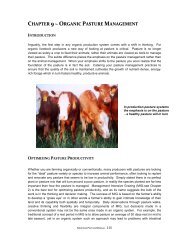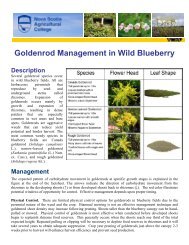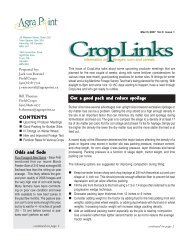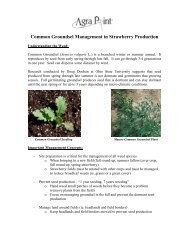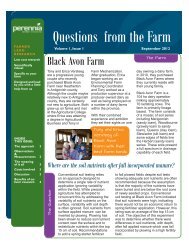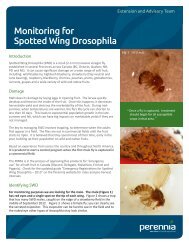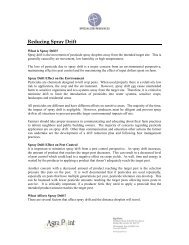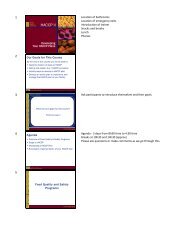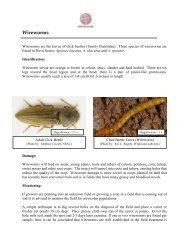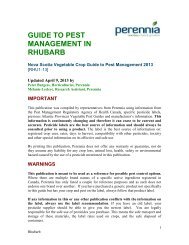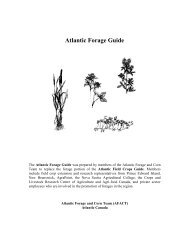Septoria Leat Spot and Stem Ganker - Perennia
Septoria Leat Spot and Stem Ganker - Perennia
Septoria Leat Spot and Stem Ganker - Perennia
You also want an ePaper? Increase the reach of your titles
YUMPU automatically turns print PDFs into web optimized ePapers that Google loves.
Wild Blueberry<br />
Fact Sheet<br />
<strong>Septoria</strong> <strong>Leat</strong> <strong>Spot</strong><br />
<strong>and</strong> <strong>Stem</strong> <strong>Ganker</strong><br />
<strong>Septoria</strong> leaf spot <strong>and</strong> stem canker is caused by a<br />
fungal species belonging to the genus <strong>Septoria</strong>.<br />
This disease can cause extensive spotting on<br />
leaves <strong>and</strong> stems <strong>and</strong> is associated with<br />
premature leaf <strong>and</strong> fruit drop. lt occurs on both<br />
Vaccinium angustifolium <strong>and</strong> V. myrtilloides, the<br />
two host species that typically comprise<br />
commercial st<strong>and</strong>s of lowbush blueberry. lt<br />
occurs annually to varying degrees in most<br />
lowbush blueberry fields throughout eastern<br />
Canada <strong>and</strong> Maine.<br />
Symptoms<br />
Figure 1. Early symptoms of infection by Sep/ora sp.<br />
showing minute water soaked spots on the undersurface<br />
of a blueberry leaf.<br />
In sprout fields, leaf lesions occur mostly on the<br />
lower leaves of stems while in fruiting fields, leaf<br />
lesions occur throughouthe canopy. The lesions<br />
first appear in mid-late June as minute water<br />
soaked spots on the leaf undersurface <strong>and</strong> are<br />
visible only with a h<strong>and</strong> lens (Fig. 1). The spots<br />
are translucent with transmitted light. With time,<br />
the spots increase in number <strong>and</strong> size <strong>and</strong><br />
become slightly raised <strong>and</strong> visible to the naked<br />
eye. The centre of a spot may become dark brown<br />
<strong>and</strong> slightly sunken while the outer edge remains<br />
water soaked <strong>and</strong> slightly raised. Tissues<br />
between lesions may become brown <strong>and</strong> lesions<br />
may be more pronounced along leaf veins. The<br />
leaf undersurface may have many lesions of<br />
different ages, <strong>and</strong> later in July, they begin to<br />
merge producing larger, irregular shaped spots<br />
Figure 2. Advanced symptoms on undersurface of<br />
blueberry<br />
that are variable<br />
leaf infected<br />
in<br />
with Sepfora<br />
size up to about<br />
sp. Lesions range<br />
5 mm in<br />
from individual small water soaked spots to larger areas<br />
diameter (Fig. 2). The lesions penetrate to the<br />
where spots have merged.<br />
upper leaf surface <strong>and</strong> appear as red/purple spots
with irregular borders. Symptom intensity <strong>and</strong> color of spots varies among clones. Leaves deep in the<br />
canopy may turn yellow instead of redipurple <strong>and</strong> appear peppered with the dark green water soaked<br />
spots. In sprout fields, the diseased lower leaves may drop during July <strong>and</strong> August (Fig. 3), but this often<br />
goes unnoticed because they are deep in the canopy. In the upper canopy of fruiting fields, the<br />
reddish/purple discoloration continues to intensify into late July <strong>and</strong> earlyAugustwhen affected clones take<br />
on an unhealthy reddish/brown appearance (Fig. 4). Clones may become severely defoliated by harvest<br />
time. By mid August, it is difficult to differentiate leaf spots caused by this disease from leaf rust, powdery<br />
mildew or other minor leaf spotting pathogens.<br />
Figure 5. <strong>Stem</strong> cankers with smallfungalfruiting bodies<br />
(pycnidia) caused by Sepfon'a sp. on a fruiting stem of<br />
lowbush blueberry.<br />
35<br />
30<br />
625<br />
+ Rawdon<br />
-o- Tatamagouche<br />
!20<br />
Figure 3. Leaf spotting, discolouration <strong>and</strong> defoliation<br />
caused by Sepfona sp. on lower portions of lowbush<br />
blueberry sprout stems.<br />
Figure 4. Symptoms of leaf spotting caused by Sepforla<br />
sp. on upper surfaces of leaves from fruiting stems<br />
ranging from individual spots to larger diseased areas<br />
where spots have merged. Lesion size, number <strong>and</strong><br />
colorvary on clones <strong>and</strong> with age of infection.<br />
_q<br />
o<br />
o<br />
a<br />
to<br />
tu<br />
5<br />
0<br />
$ roo<br />
g e 0<br />
8 8 0<br />
8 7 0<br />
€ 6 0<br />
; 5 0<br />
R+o<br />
9 3 0<br />
t 2 0<br />
H t o<br />
3 u<br />
a<br />
Open; i<br />
Raw. 1Oo/" ; I<br />
Tat.2o/o -i<br />
6<br />
'16<br />
26<br />
May<br />
Open/set;<br />
Raw.41Vo<br />
rat. 39o/o<br />
I<br />
,I<br />
I set;<br />
I Raw. 100%<br />
rat. e8%<br />
I<br />
5 1 5 2 5 5 1 5 2 5 4 1 4 2 4<br />
June July August<br />
Date In 2008<br />
Figure 6. Example of seasonal spore production by<br />
<strong>Septoria</strong> sp. on infected, overwintered leaves in fruiting<br />
fields at Rawdon <strong>and</strong> Tatamagouche in 2008. A) Spores<br />
produced per leaf. B) Spore data are presented as<br />
cumulative seasonal spore production in relation to crop<br />
development; the percentages of open, open <strong>and</strong>/or set .-<br />
<strong>and</strong> set flowers are presented on the graph for each<br />
location. For example, at Rawdon <strong>and</strong> Tatamagouche, \-/<br />
respectively, 100% <strong>and</strong> 98% of the flowers were set by<br />
June 23, <strong>and</strong> about 90-95% of the total spores from<br />
ovenvintered leaves had released bythattime.
Lesions from infections<br />
the sprout year also occur on fruiting stems <strong>and</strong> are easy to identify in late Aprilearly<br />
May before the foliage develops. They initially appear as red/purple spots variable in size (0.5-10 mm<br />
long) <strong>and</strong> are confined to the lower half of the stem. They exp<strong>and</strong> with time <strong>and</strong> by late May-early June the<br />
centres turn brown <strong>and</strong> become slightly sunken at which time they are referred to as cankers (Fig. 5). By<br />
late June, several cankers may merge causing much of the lower half of stems to be affected, but stems are<br />
usually not killed. This is in contrast to Godronia canker which causes lesions only at leaf nodes <strong>and</strong> kills<br />
stem tissues above the pointof infection.<br />
Disease Gycle<br />
Small black fruiting bodies of the fungus called pycnidia begin to develop on diseased fallen leaves<br />
primarily in September <strong>and</strong> October <strong>and</strong> continue to mature during April <strong>and</strong> May of the following spring.<br />
Spore release occurs most intensively over a 3-4 week period beginning<br />
late May in response to rain. In<br />
sprout fields, only those leaves <strong>and</strong> stem portions that have exp<strong>and</strong>eduring this time are exposed to<br />
spores explaining why the lower leaves of sprout stems become more severely diseased. The<br />
characteristic minute water soaked spots begin to appear on leaves about 1O-14 days after infection, but do<br />
not become visible to the naked eye until about 4 weeks after infection. With time, the lesions intensify<br />
number <strong>and</strong> exp<strong>and</strong> <strong>and</strong> by mid to late July the leaves begin to drop if disease is severe. Although stem<br />
tissues also have been exposed to spores <strong>and</strong> become infecte during this time, stem cankers do not<br />
develop until the following spring.<br />
In the spring of the fruiting year, spore release from overwintered leaves follows the same seasonal pattern<br />
that occurs in sprout fields with most coinciding with the bloom period (Fig. 6). First spores are released<br />
when fruiting fields have about 1-10o/o open flowers <strong>and</strong> by the end of the bloom period, the majority of<br />
spores have been released. Spore production closely follows the bloom period regardless if the season is<br />
early or late. Release of spores from pycnidia in leaves <strong>and</strong> stem cankers occurs simultaneously every<br />
time rain occurs <strong>and</strong> spores are splashed onto the foliage. Infection of leaves occurs only on the<br />
undersurface. By mid to late July, severely diseased leaves begin to drop. Research is continuing<br />
the<br />
effects of temperature <strong>and</strong> wetness duration in relation to infection.<br />
In general, prolonged wet weather during June favours spore release <strong>and</strong> infection while subsequent<br />
prolonged hot dry weather causing moisture stress during July <strong>and</strong> August promotes drop of infected<br />
leaves <strong>and</strong> fruit.<br />
Although some secondary pycnidi<strong>and</strong> spores may be produced on fallen, infected current season leaves,<br />
they are considered far less important than the primary pycnidi<strong>and</strong> spores that occur during late May <strong>and</strong><br />
June. Secondary spores may occur in late July <strong>and</strong> August. The disease cycle is summarized in Figure 7.<br />
Disease Management<br />
Burn pruning after the fruiting phase of production can reduce this disease, but if conditions are highly<br />
favourable for infection during the subsequent sprout phase, then leaf <strong>and</strong> stem infections may still be high<br />
enough to result in high spore populations in the following fruiting year. In order for burning to reliably<br />
reduce this disease, it must be done intensively <strong>and</strong> uniformly throughout a field to destroy infected leaf <strong>and</strong><br />
stem litter. Researchas shown that fungicide applications during the spore release period (beginning at<br />
1-10% bloom) can protect foliage from infection, but the decision to apply a fungicide may be difficult to<br />
make. In general, if premature leaf drop has been severe before harvest in previous years, fungicide<br />
applications may be beneficial in the current fruiting season. The percentage of stems with spots/cankers<br />
observed in early May of the fruiting year may also help to guide the decision whether to apply a fungicide.<br />
High numbers of affected stems indicate that infection was severe in the previousprout year <strong>and</strong> that<br />
many cankers <strong>and</strong> ovenruintered leaves may produce high spore populations that pose a threato the<br />
foliage of the current fruiting stems. Researchas shown that attempting to control the disease with<br />
fungicides in the sprout phase does not appear to be cost effective. Pest management guide should be<br />
consulted forfungicide recommendations in the fruiting year.
Infection Gycle of <strong>Septoria</strong> in Lowbush Blueberry<br />
'<br />
Sprout year<br />
-/<br />
A)-<br />
l"oor."are rain sPlashed from<br />
l' r-.|py' overwintered leaves onto developing<br />
U/-)l-, \ stems <strong>and</strong> leaves from late Mav until<br />
{E Nf ) earlvJulv<br />
I W I @ /<br />
'<br />
ffi<br />
- St"r infections remain dormant <strong>and</strong><br />
r€i*q\-q<br />
are not visible until the following<br />
fruiting year<br />
\<br />
- Lower leaves (usually bottom half)<br />
drop in July <strong>and</strong> August (can be<br />
confused with the effects of leaf rust)<br />
- Secondary infection may occur<br />
during late July - August (minor<br />
importance)<br />
Pruning in the<br />
fall or spring<br />
- Defoliation <strong>and</strong> fruit drop occurs<br />
in late July <strong>and</strong> August (can be<br />
confused with the effects of leaf<br />
rust)<br />
- Secondary infection may occur<br />
during late July - August (minor<br />
importance)<br />
-Lesions on lower stems (usually<br />
bottom half) become visible in<br />
April- May<br />
- Spores are rain splashed from<br />
overwintered leaves <strong>and</strong> stem<br />
lesions onto young leaves<br />
beginning from late Mav (1-10%<br />
bloom) until earlv Julv<br />
Fruiting year<br />
Figure 7. Infection cycle of <strong>Septoria</strong> sp. in lowbush blueberry.<br />
Prepared by: P.D. Hildebr<strong>and</strong>, W.E. Renderos, Agriculture <strong>and</strong> Agri-Food Canada, Kentville, NS; R.W. Delbridge, Delbridge Disease<br />
Management, Kentville, NS <strong>and</strong> P. Burgess, AgraPoint, Truro, NS; <strong>and</strong> the Wild Blueberry Producers Association of Nova Scotia, Debert, NS.<br />
March 2011.<br />
l*I<br />
A8ii-#i#*." A3i5i,',lHf"i"'irecanada<br />
ILUEBENRY<br />
PRODUCENS<br />
ASTOCIATION<br />
/rgra P int-<br />
Canadian Wild Blueberry Industry<br />
Research & Development Institute Inc.<br />
L'institut canadien de recherche et de developpemenl<br />
de l'induslrie du bleuet sauvage.



